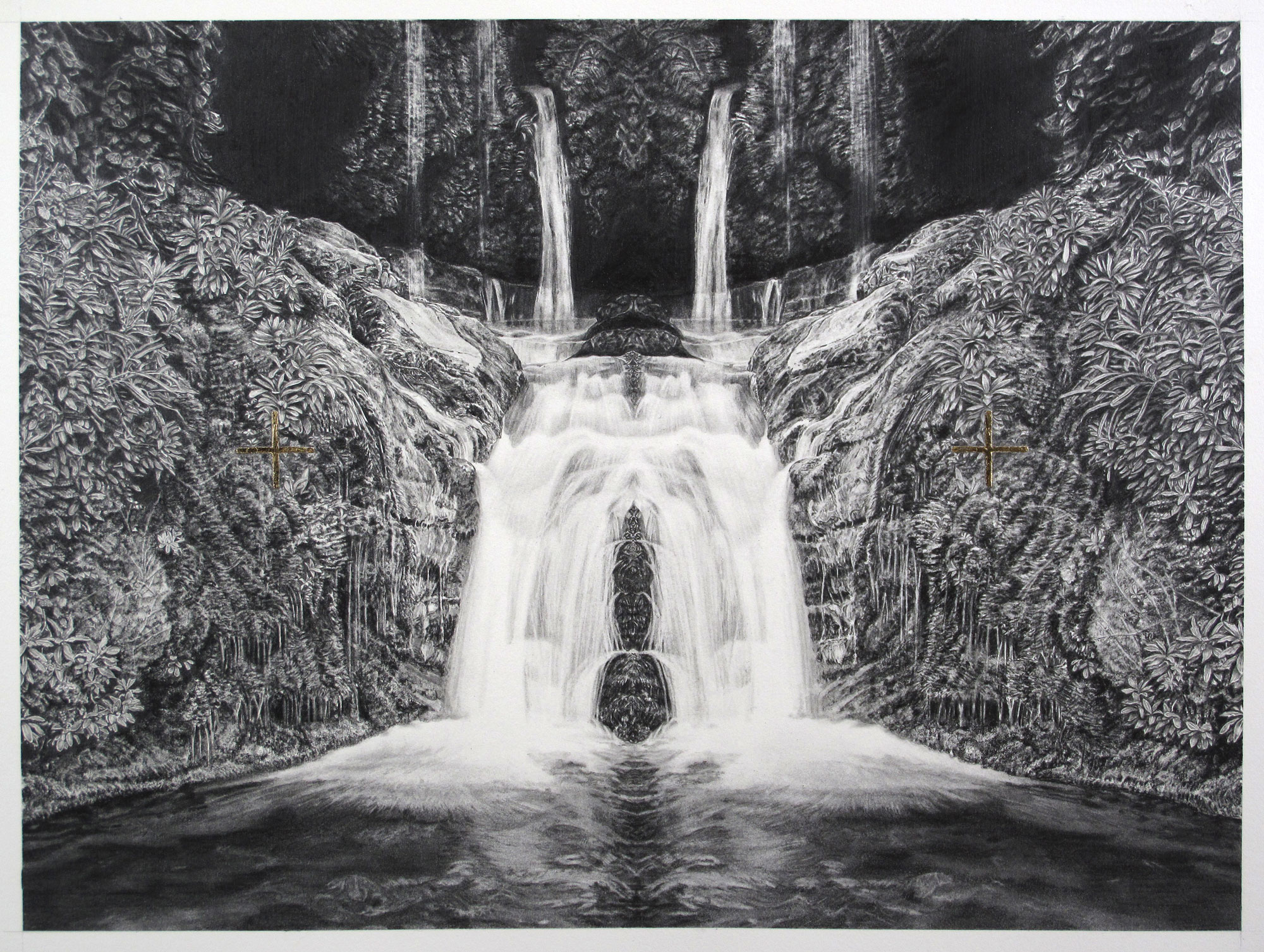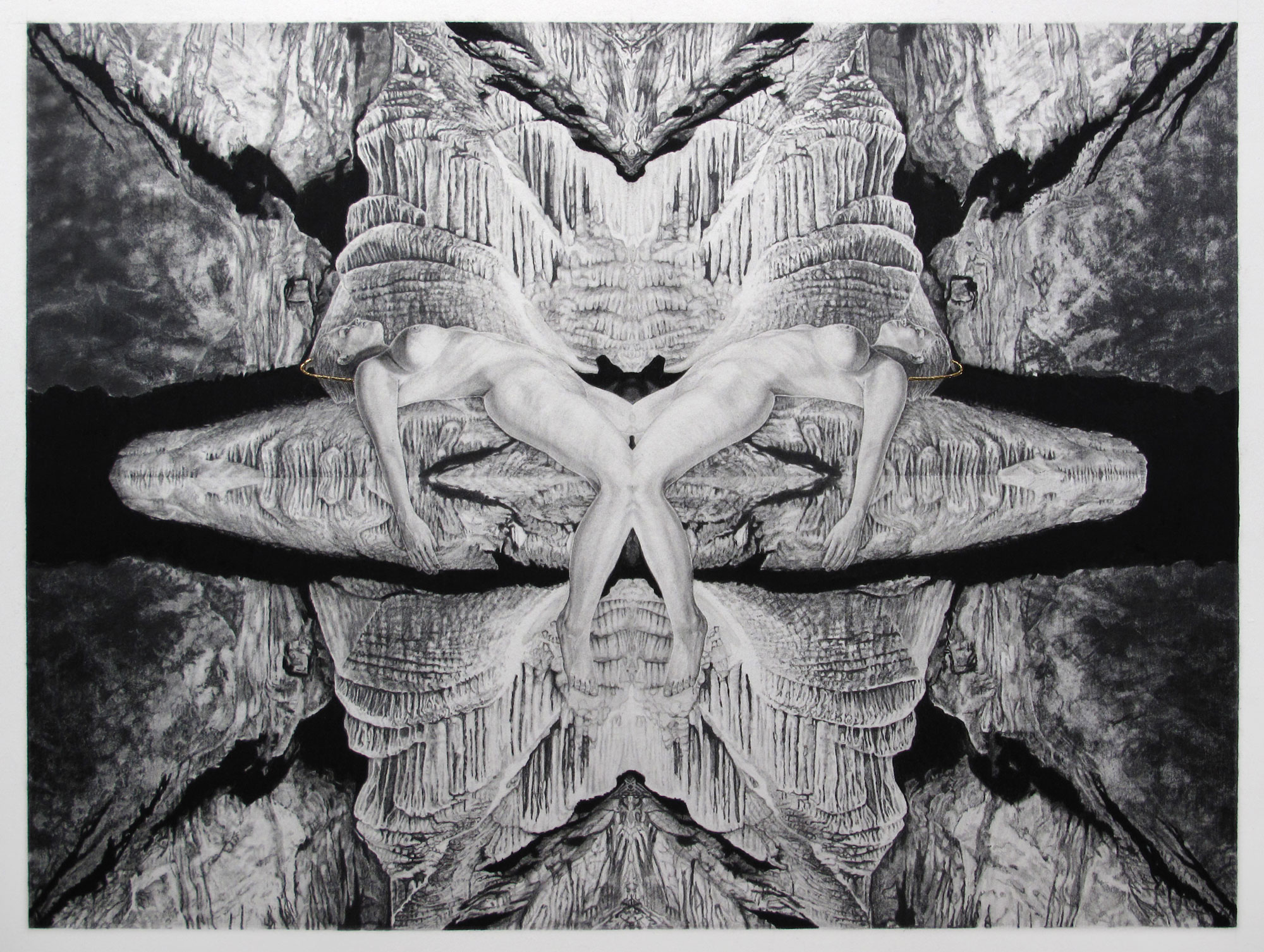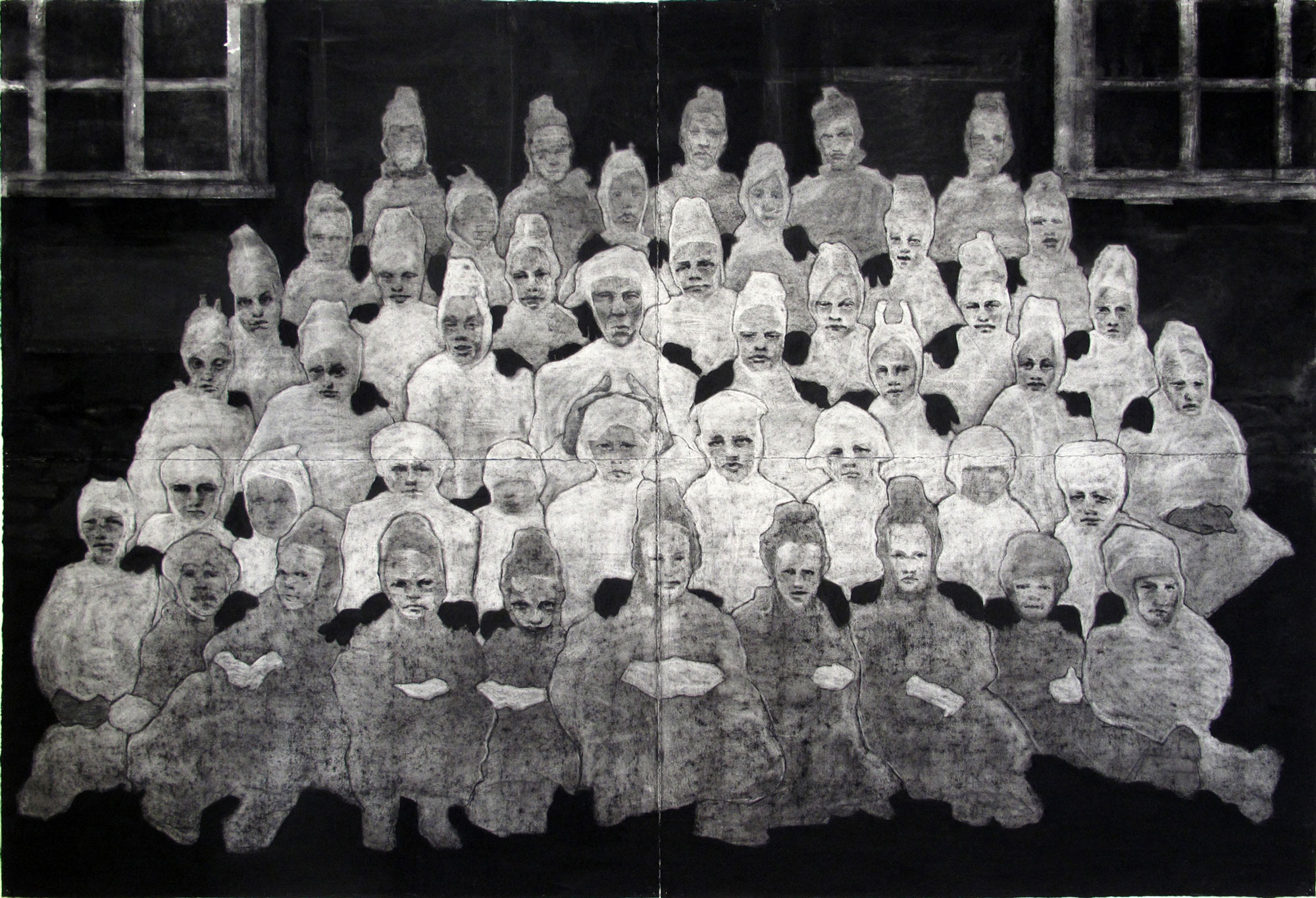In Conversation with Becc Ország
'INAUGURAL' exhibition interview
NICHOLAS PROJECTS, 2015
BY KATIE PAINE



A foaming waterfall forks into two inky rivers of unknown depths, defying the laws of nature. Figures assemble awkwardly for a group portrait, their bodies blurring into one organism, only their faces recognisable. Young girls gather, their bodies swaying in some incomprehensible ritual, a man’s contorted body raised overhead as a result of a formidable magic. Have we stepped through Alice’s looking glass, and stumbled upon a netherworld, an alternate reality in which the world is endlessly repeated, tessellated and fractal?
Melbourne artist Becc Ország creates exquisite drawings that pull their viewer into eerie and fantastical other worlds. Despite an underlying element of the bizarre, Ország’s body of work is steeped in human past and in art history. Histories, both real and imagined, are crucial to Orszag’s practice. In her Immaculate Landscape series there is something of the devotional: perhaps of gilded illuminated manuscripts or fantasies of a Garden of Eden. 'Immaculate Landscape V', sprawling with the minutiae of foliage is reminiscent of meticulous Victorian naturalism: Millais painting the river in Ophelia for hours en plein air. In 'Immaculate landscape VI', a naked woman lies suspended in an a rocky chasm, engulfed in an erotic rhapsody that brings to mind Bernini’s Ecstasy of Saint Theresa.
Within their wooden frames, these images are almost like dioramas, or stereoscopes…one becomes wholly absorbed in each drawn universe. Ország sources found photographs, amalgamating random unconnected images until she has created an imagined universe where events and individuals collide, creating fictitious moments. With an interest in social constructs, Ország creates alluring composites to question established regimes, questioning politicised master narratives.
KP: What was your practice like at the beginning of your career?
BO: I certainly gained more confidence as my years of study wore on. … 'Cannot Contain This' is a drawing I made in my second year at uni. It was a first for me in a sense that it was the first time I felt truly confident in what I was making, it felt like a breakthrough conceptually and technically- in size too (previously my works had been a lot smaller). Also, it was one of the first where I deviated from using my own imagery, working with found imagery and really started exploring the idea of collective history.
KP: Have there been moments that have significantly altered your practice?
BO: Leaving art school was definitely a pivotal moment, there’s a change to your surroundings, your studio practices - It can’t help but inform it.
KP: How has your studio practice changed since graduating from RMIT?
BO: I’m definitely more solitary, it’s such a different environment in art school-so many people you can talk with, who can challenge you. Actually, when I first graduated I had a studio in the Nicholas Building, I’ve always loved its sense of history, so it’s great to be back here for Inaugural. But working in a more solitary way suits me; I’m more productive- I can get enveloped in the medium, in the universe of the drawing.
KP: And so where do you source your images?
BO: I used to use familiar material, like family photos. I made this departure as I like the anonymity of working from archival photographs and images from the web.
KP: Memory, be it real or imagined seems to play a large component of your practice. Can you tell us more about the role it plays?
BO: I’m very interested in the fallible and malleable aspect of memory, particularly when it comes to official histories, twisting of truths, and the way a collective’s thoughts and beliefs can alter an individual’s memory-often regardless of rationality and intuition.
KP: I’ve noticed in some of your works you leave notes in the border of the works-Tell me about that…
BO: The notations often come from subconscious thought and appear at all stages of the drawing process. I’m usually not sure what they mean at the time that I write them, it’s usually just me trying to understand what that particular drawing, or even body of work, is about. The notes also work to create an accidental narrative across my practice, that is continually unfolding and revealing meaning within corresponding works.
KP: Building on from that- I’ve noticed that your works’ titles seem very significant, like an extension of your work.
BO: I think of the titles as a line taken from a story that simultaneously reveals itself as the works are made, so like the notations they do help me in trying to understand what exactly is going on in the work, but without wholly defining it.
KP: Drawing in many ways is a language as much as text…How do you feel the two languages intertwine in your work?
BO: I think they can both very easily become very literal and that is something that I really want to avoid. I think people look to text for answers too often, so I use that to throw the viewer off. I don’t want to give answers, I want to make people figure it out for them selves… Text and imagery can play off each other in a really nice way, I think there is something comforting about seeing a line of text, again, maybe because it’s expected to explain something and bring a kind of relief.
KP: Talk to me about your intention for the works you made for Inaugural.
BO: I’ve been working with the idea of peace and perfection by looking towards religious tropes like heaven and the divine. I’m trying to break apart that longing for utopia, for salvation, for peace and bring it back to the self by exploring what is actually within us that draws us to such ideals and critiquing looking out of the self for answers. The Immaculate Landscape drawings are attempts at creating this utopic environment; the struggle to create the existence of such a place is evident within the sense of disquiet in these beautiful and detailed environments.
KP: Yeah, it’s like you’re creating new alternate realities for your subjects by compositing. With your work, the act of drawing seems to be an act of recovery…
KP: You write about Utopic and Dystopic ideals-can you tell me more about how these notions manifest in your work….
BO: It’s in the struggle between the beauty in detail within the serene landscapes and a sense of foreboding and disquiet. It looks perfect but you know something is not right, it keeps you on your feet, questioning.
Katie Paine is an artist, curator and writer and currently the Public Programs Director for Nicholas Projects. nicholasprojects.org